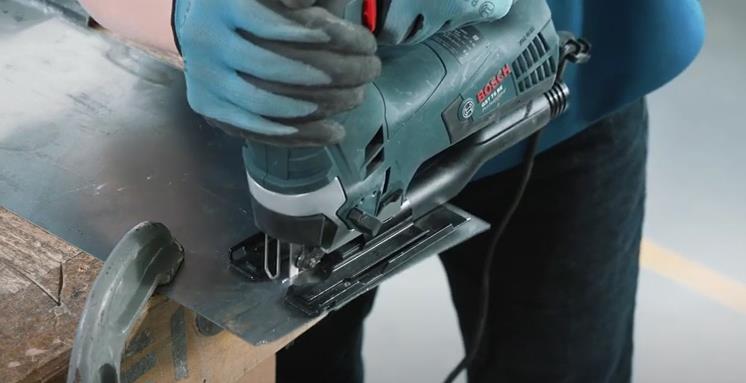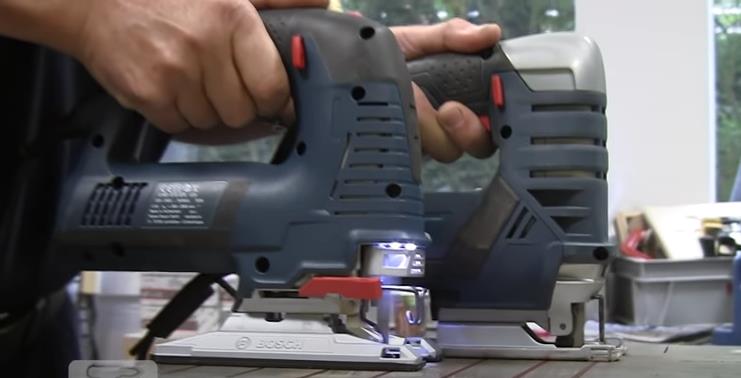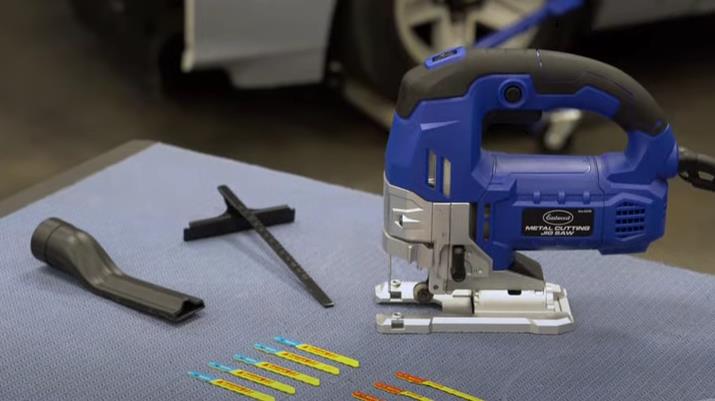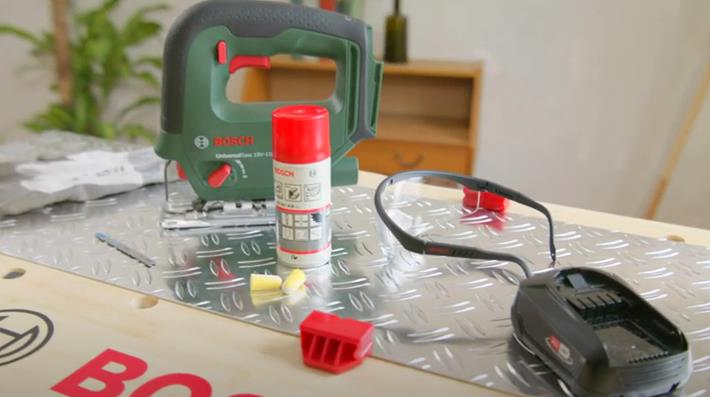With a metal cutting blade.
The possibilities of a jigsaw are often overlooked. From the most complex DIY project to the most precise workmanship, a jigsaw can be used for various applications. But how can a jigsaw cut metal? With the right setup and proper technique, jigsaws can become a powerful tool for cutting metal.
Jigsaws are extremely versatile power tools that may cut various materials, including metal. To properly cut metal with a jigsaw, it is essential to use the appropriate blade and adhere to the appropriate cutting techniques.
However, If you’re looking for a way to cut through metal with precision and ease, you’ll want to check out a jigsaw. This blog looks at the different materials that cut jigsaws and how to cut them to get the most out of your project and avoid surprises.
So let’s get started.
How Can A Jigsaw Cut Metal?

With these tips in mind, let’s take a look at the steps you need to follow to cut metal with a jigsaw:
Step-1: Choosing the Right Blade
The first step in cutting metal with a jigsaw is selecting the right blade. Make sure to use a metal-cutting blade with much sharper teeth than a wood-cutting blade. The blade should also be suitable for the type and thickness of the metal cut. Then insert a metal-cutting blade into your jigsaw.
Step-2: Prepare the Metal
Before you cut the metal, make sure it is firmly clamped to a stable surface. This will keep it from moving while you cut it. Mark out the area you want to cut with a pencil or marker. This will give you a guide to follow as you cut.
Step-3: Put on Safety Gear
Wear safety glasses to cover your eyes from sparks or metal chips that might fly at you.
Step-4: Change the Speed
If your jigsaw has a trigger that lets you change the speed, set it to a speed that works well for cutting metal. Most of the time, thicker metal should be cut at a slower speed, while thinner metal can be cut at a faster speed.
Step-5: Start the Cut
After setting your jigsaw to the correct speed for the thickness of the metal, you’re cutting. Place the blade of your jigsaw onto the marked line. Please turn on the jigsaw and carefully move it along the cutting line in a steady, controlled way. Make sure to press down on the blade in a steady, even way as it cuts through the metal.
Step-6: Use a Straightedge or Clamps
If you need to make a straight cut, use a straightedge or clamps to keep the blade from wandering.
Step-7: Stop the Jigsaw
When you’re done cutting, turn off the jigsaw and carefully remove the metal from the clamps. Clean the cut edge using a wire brush or sandpaper to remove any metal burrs or rough spots.
Note: Always follow the jigsaw’s manufacturer’s instructions, including any safety measures, to ensure you use the tool safely and competently.
What Are Some Things To Keep In Mind When Cutting Metal With Jijgsaw?
As long as we know how can a jigsaw cut metal, now let’s know what the things to keep in mind when cutting metal with a jigsaw are.
If you’re looking to cut metal with a jigsaw, there are a few things you need to keep in mind.
- First, you need to have a jigsaw with a metal-cutting blade. These blades are usually made of high-speed steel or bi-metal and have a teeth count of 18-24 TPI (teeth per inch).
- Second, you need to use the correct speed setting on your jigsaw. For thin metal, you’ll want to use a lower speed, while thicker metal will require a higher speed.
- Finally, you need to apply adequate pressure to the jigsaw as you’re cutting. If you’re cutting through thick metal, you may need to use both hands to apply enough pressure.
The Benefits Of Using A Jigsaw To Cut Metal

The benefits of using a jigsaw to cut metal are that it is a very versatile tool that can be used to cut a variety of materials, including metal, and that it is relatively inexpensive.
A jigsaw is a handheld power tool that can be used to cut various types of materials, including wood, metal, plastic, and ceramic tile. Jigsaws are available in both corded and cordless versions. There are many benefits to using a jigsaw to cut metal. Like:
- The main advantage of using a jigsaw is that it can make curved or intricate cuts that would be difficult to make with other types of power saws.
- Another advantage of using a jigsaw is that it is relatively easy to operate.
- Most jigsaws have a trigger to turn the blade on and off. Some models also have a variable speed trigger, which allows the user to control the speed of the blade.
- When cutting metal with a jigsaw, it is essential to use a blade that is designed for that purpose. Metal-cutting blades have teeth that are much sharper than those of wood-cutting blades. These blades can also cut other materials, such as plastic and ceramic tile.
Disadvantages of Using a Jigsaw
- It can be difficult to make straight cuts. This is because the blade tends to wander when cutting. For this reason, using a straightedge or clamp is vital to guide the blade when making straight cuts.
- Another disadvantage of using a jigsaw is that it can be somewhat dangerous. This is because the blade is exposed and can cause serious injury if the saw is not used correctly. For this reason, it is essential to read the owner’s manual carefully and to wear safety glasses when using this type of saw.
Despite these disadvantages, a jigsaw can be a useful tool for anyone who needs to make intricate or curved cuts. When used properly, it can be a safe and easy way to cut various types of materials.
How Does A Jigsaw Work?
It cuts curved and irregular shapes using a fragile blade.
A jigsaw is a type of power saw that uses a reciprocating blade to create irregular cuts in wood. It is commonly used to cut intricate shapes or make curved wood cuts.
A jigsaw consists of a handle, a base plate, a blade guard, and a blade. The handle is usually made of plastic and is connected to the base plate. The base plate is made of metal and is mounted on the saw. The blade guard is made of metal and is attached to the base plate. The blade is made of steel and is mounted on the blade guard.
The jigsaw is turned on, and the blade is inserted into the workpiece. The blade is then moved up and down to create the desired cut.
Here is a video that shows how a jigsaw works:
What Types Of Metal Can A Jigsaw Cut?
A jigsaw can cut through thin metals, such as aluminum.
A jigsaw is a powerful tool that can cut straight, curved, or crooked lines in many different kinds of materials. While most people think of a jigsaw as a wood-cutting tool, it can also be used to cut metal. The type of you use.
There are two main types of jigsaw blades: those for cutting wood and those for cutting metal. The teeth on a wood-cutting blade are larger and more widely spaced than those on a metal-cutting blade. This is because metal is harder and requires a blade with smaller, sharper teeth to make a clean cut.
Most jigsaw blades are made from high-carbon steel, which is a good choice for general-purpose cutting. However, if you plan to do a lot of metal cutting, you may want to invest in a blade made from bi-metal, a harder, more durable type of steel.

Now that you know what kind of blade to use, let’s take a look at some of the different types of metal you can cut with a jigsaw:
Thin sheet metal:
This is the most accessible type of metal to cut with a jigsaw. You can use either a wood-cutting or metal-cutting blade, although a metal-cutting blade will give you the best results. For the best results, use a blade made of high-carbon steel or bi-metal.
Aluminum:
Aluminum is a bit more challenging to cut than sheet metal, but it can still be done with the right blade. For best results, use a bi-metal blade designed specifically for cutting aluminum.
Stainless steel:
Stainless steel is one of the most challenging metals to cut with a jigsaw. You’ll need to use a bi-metal blade with tiny teeth to get a clean cut.
Copper:
Copper is similar to stainless steel in terms of its hardness. You’ll need a bi-metal blade with tiny teeth to get a clean cut.
Now that you know what types of metal you can cut with a jigsaw, it’s time to get to work. Just select the right blade for the job and take your time to ensure a clean, precise cut.
How Thick Of A Metal Can A Jigsaw Cut?
A jigsaw can cut through metal up to 6mm thick.
A jigsaw is a power tool that can cut through various materials, including wood, plastic, and metal. When it comes to metal, the thickness that a jigsaw can cut through depends on the blade used. For example, a blade designed for cutting through thin metal may be unable to cut through thick metal.
Generally, a jigsaw can cut through metal up to 1/8 of an inch thick. If you are trying to cut through metal that is thicker than that, you will likely need to use a different type of power tool, such as a Sawzall.
One real-life example of a jigsaw being used to cut through metal is when someone is trying to cut through a metal pipe. A jigsaw can easily cut through the metal pipe as long as the right blade is used.
Some Essential Tips For Using A Jigsaw To Cut Metal
Use a jigsaw with a blade designed to cut metal.

A jigsaw is a versatile tool that can be used to make clean, precise cuts in a variety of materials. When cutting metal, there are a few things to keep in mind to get the best results. Like:
Choose the Right Type Of Blade
First, it is essential to use a blade designed specifically for cutting metal. Jigsaw blades are available in various materials, each of which is better suited for cutting different types of metal. For example, a blade made of high-speed steel is a good choice for cutting soft metals like aluminum, while a tungsten carbide-tipped blade is better for cutting harder metals like steel.
Correct Speed Setting
Second, it is vital to use the correct speed setting when cutting metal. If the blade moves too slowly, it will overheat and wear out quickly. If the blade is moving too quickly, it may break. The best way to determine the correct speed is to experiment and find the best setting for the metal you are cutting.
Use Steady
Using steady, even pressure when cutting metal is essential. Pushing too hard can ultimately cause the blade to bind, break, or even come out of the jigsaw. Conversely, not pushing hard enough will make it difficult to get a clean, precise cut.
Using lubricant
Finally, it is vital to use a lubricant when cutting metal. This will help to keep the blade cool and extend its life. A few drops of cutting oil or WD-40 should be sufficient.
With these tips in mind, cutting metal with a jigsaw can be a breeze. Give it a try the next time you need to make a precise cut in metal!
FAQ
How Do You Change The Blade On A Jigsaw?
To change the blade on a jigsaw, first, remove the old blade by unscrewing the retaining screws. Next, insert the new blade into the blade holder and re-tighten the retaining screws.
What Are Some Safety Precautions To Take When Using A Jigsaw?
There are a few safety precautions to take when using a jigsaw:
1. Wear eye protection to avoid sawdust and debris from getting in your eyes.
2. Wear gloves to avoid getting cuts on your hands.
3. Clamp the workpiece down to avoid it from moving while you’re cutting it.
4. Start the cut with the blade on the waste side of the line to avoid kickback.
What Are Some Common Problems That Can Occur When Using A Jigsaw To Cut Metal?
The most common problem when using a jigsaw to cut metal is that the blade can overheat and break. If the blade overheats, it can cause the metal to warp and the jigsaw to stop working.
Where Can I Find More Information On Using A Jigsaw To Cut Metal?
There are a few ways to find more information on using a jigsaw to cut metal. One way is to do a general search on the internet, which will provide a variety of results from different sources. Another way is to go to your local library and look for books or magazines on the subject. You could also try asking someone who is experienced in using a jigsaw to cut metal for advice.
Final Words
A jigsaw cut metal is a tricky process requiring precision and practice. If done incorrectly, it can cause damage to the metal surface that you are trying to cut. But using a jigsaw to cut metal can be a quick and accurate way to do it, as long as you use the right blade and make the right plans.
When using a jigsaw to cut metal, it is vital to make sure that the metal is securely clamped, that the correct speed setting is used, and that the blade is oiled so it doesn’t get too hot.
If you follow these steps and take the proper safety precautions, you can use a jigsaw to make a clean, precise cut that will save you time and effort compared to other ways to cut metal.
Hopefully, you are now clear on how can a jigsaw cut metal. If you have any remaining questions, please don’t hesitate to comment below.


7 thoughts on “How Can A Jigsaw Cut Metal? Expert Tips and Techniques”
Comments are closed.